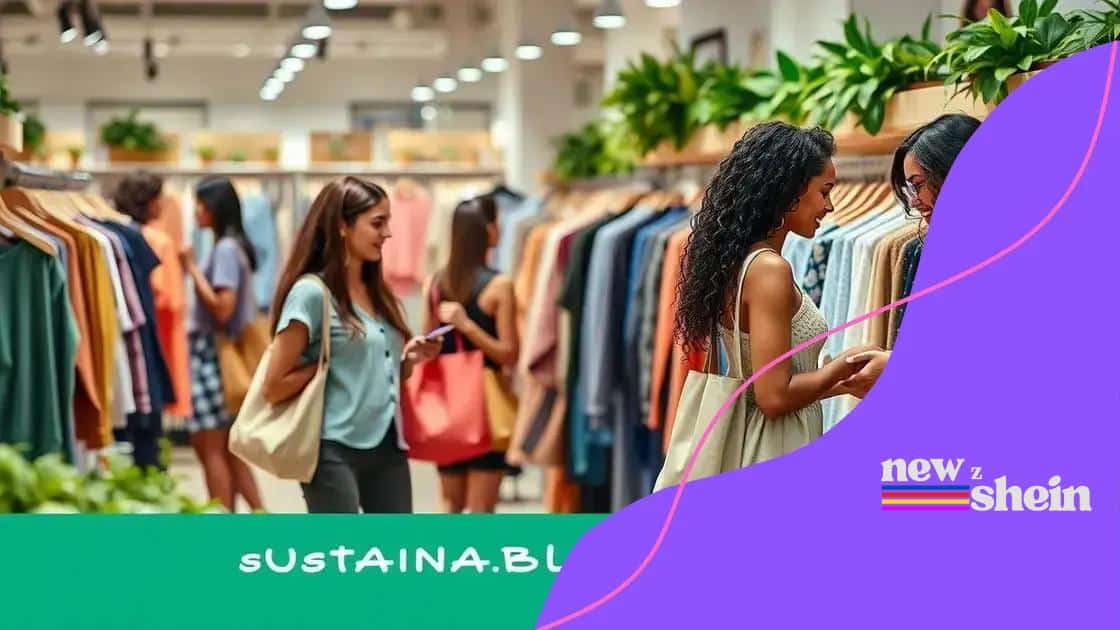Shein’s financial support for sustainable sourcing

Shein’s financial support for sustainable sourcing enables the brand to enhance eco-friendly practices, accelerate production efficiency, and respond to growing consumer demand for transparency and responsible fashion choices.
Shein’s financial support for sustainable sourcing is reshaping the landscape of fast fashion. But how does this funding actually make a difference? Let’s dive into its implications and potential benefits.
Understanding Shein’s sustainability goals
Understanding Shein’s sustainability goals is crucial in unpacking its impact on the fashion industry. The brand aims to reshape the traditional fashion landscape by integrating eco-friendly operations.
Key Sustainability Initiatives
Shein has started several initiatives that focus on sustainable sourcing and production. These efforts demonstrate a commitment to reducing environmental impact while maintaining competitive pricing.
- Investment in eco-friendly materials
- Partnerships with sustainable fashion organizations
- Implementation of transparent supply chains
Additionally, Shein focuses on consumer education regarding sustainability. This involves providing information on responsible consumption and sustainable fashion choices.
Collaborations for Greater Impact
Collaboration with various organizations allows Shein to amplify its sustainability efforts. By working with industry leaders, the brand gains access to innovative technologies and practices. These partnerships enhance Shein’s ability to promote and implement sustainable practices effectively.
Shein’s goals also encompass reducing waste throughout the production process. This entails utilizing digital solutions to minimize excess and improve efficiency. As the brand advances, its vision remains anchored in adaptability and growing awareness of environmental issues.
The Future of Shein’s Sustainability Efforts
Looking ahead, the brand is set to expand its sustainability goals even further. Focused on continuous improvement, Shein plans to enhance its sustainability tracking and reporting. By doing this, it aims to increase accountability and foster consumer trust.
Ultimately, Shein’s sustainability goals reflect a shift toward a more conscious fashion industry. As consumers become more aware of the environmental impact of their choices, brands like Shein are pressured to evolve in ways that prioritize the planet.
The impact of Shein’s funding on sourcing practices
The impact of Shein’s funding on sourcing practices is significant in reshaping the supply chain of the fashion industry. With increased investments, Shein can enhance its efficiency and focus on sustainability.
Efficient Sourcing Practices
Thanks to its financial resources, Shein can collaborate with suppliers who prioritize sustainable methods. This enables the brand to secure eco-friendly materials while keeping costs manageable. Furthermore, improving sourcing practices means reducing lead times and increasing product turnover.
- Development of sustainable suppliers
- Reduction of lead times in production
- Improved inventory management
As a result, consumers benefit from a wider array of sustainable fashion options. Shein’s commitment encourages suppliers to adopt greener practices, creating a ripple effect in the market.
Support for Innovation
Funding also plays a crucial role in supporting innovation. By investing in new technologies, Shein can improve its sourcing logistics. This involves using data analytics to better forecast demand and manage supplies effectively.
Additionally, Shein’s efforts to understand consumer preferences lead to more targeted sourcing strategies. This dual approach optimizes the supply chain, making it both efficient and environmentally friendly.
Collaborative Efforts in Sustainability
Shein’s financial backing enables partnership with various organizations aimed at promoting sustainable fashion. Through these collaborations, the brand fosters a culture of responsibility among its suppliers and enhances transparency throughout the sourcing process.
As Shein continues to invest in its sourcing practices, the impact on the industry becomes more pronounced. The shift toward sustainability encourages other brands to follow suit, ultimately transforming the entire fashion landscape.
Consumer response to sustainable initiatives

The consumer response to sustainable initiatives is crucial for the success of brands like Shein. As consumers grow more aware of environmental issues, their preferences start to shift toward eco-friendly options.
Growing Demand for Sustainability
Many shoppers now actively seek out brands that prioritize sustainability. This trend reflects a desire to make responsible purchasing decisions. Companies that embrace sustainable practices tend to attract a more conscious consumer base.
- Increased interest in eco-friendly products
- Demand for transparency in sourcing
- Willingness to pay more for sustainable options
This growing demand compels brands to adapt their strategies. Shein, for instance, is responding to these expectations by enhancing its sustainable initiatives.
Influence of Social Media
Social media also plays a significant role in shaping consumer perceptions. Platforms like Instagram and TikTok amplify messages about sustainability. Influencers and eco-conscious celebrities often promote sustainable fashion, further boosting public interest.
This online influence encourages companies to showcase their sustainability efforts. By doing so, they create stronger connections with their audience, who value environmental responsibility.
Challenges and Opportunities
Despite the positive response, challenges remain. Some consumers remain skeptical of brands’ sustainability claims, often labeling them as “greenwashing.” To combat this, brands must communicate their efforts clearly and authentically.
Moreover, companies that effectively engage with their customers on sustainability can turn skeptics into advocates. By sharing stories and demonstrating genuine commitment, brands like Shein can strengthen relationships with their consumers.
Ultimately, consumer demand for sustainability is reshaping the fashion landscape. As more individuals prioritize eco-conscious choices, brands must continue to innovate and align with these values to stay relevant.
Comparing Shein’s approach to rivals
Comparing Shein’s approach to rivals reveals significant differences in sustainability strategies among fashion brands. As fast fashion grows, brands are pressured to adapt and innovate in order to remain competitive.
Speed and Efficiency
One of Shein’s standout features is its speed in bringing new designs to market. The brand utilizes a data-driven approach, allowing for rapid response to trends. This agility contrasts with traditional retailers who may take longer to produce and release new styles.
- Quick turnaround times for new releases
- Real-time data analysis for trend forecasting
- Efficient supply chain management
By contrast, many rivals may focus on slower, more deliberate production cycles that can hinder their ability to stay relevant as trends evolve.
Sustainable Sourcing Practices
While Shein is making strides in sustainability, its rivals often have more established practices. Brands like H&M and Zara have long promoted recycling programs and sustainable materials. These rivals can leverage customer perceptions built over years of marketing sustainability as a core value.
In comparison, Shein is relatively new to the sustainability conversation. The brand is actively working to enhance its image by investing in eco-friendly practices, but it still has a way to go compared to these experienced competitors.
Consumer Engagement and Marketing
Marketing strategies also vary significantly. Shein’s strong social media presence engages consumers directly. Influencer partnerships help amplify its reach and enhance brand visibility, appealing to younger audiences.
In contrast, rival brands often rely on established advertising channels. Shein leverages user-generated content to create a community feel, inviting customers to share their purchases and styles online.
Ultimately, the comparison between Shein and its rivals highlights the evolving landscape of fast fashion. As Shein refines its approach to sustainability and consumer engagement, it will continue to reshape industry standards alongside its competitors.
Future projections for sustainable fashion
Future projections for sustainable fashion indicate significant changes in the industry as consumers demand more eco-friendly practices. The shift towards sustainability will affect how brands operate and how consumers shop.
Technological Advancements
Technological innovations will play a key role in the future of sustainable fashion. Brands are investing in new materials that are sourced responsibly and are environmentally friendly. Innovations like recycling technologies are expected to help reduce textile waste.
- Growth of biodegradable materials
- Improvements in fabric recycling methods
- Integration of digital platforms for supply chain transparency
As these technologies evolve, the fashion industry will become more sustainable and efficient.
Consumer Awareness and Education
Education will also help shape the future of sustainable fashion. As consumers become more informed about the environmental impacts of their choices, they will demand greater transparency from brands. This awareness will encourage brands to adopt ethical practices.
Consequently, we will likely see more brands providing information about their sourcing, production processes, and labor practices. This shift can promote trust and loyalty among consumers.
Regulatory Changes
Regulations are expected to increase, pushing brands to comply with stricter environmental standards. Governments around the world are starting to take action against pollution and waste, leading to significant changes in manufacturing processes.
These regulations can create a level playing field, forcing even established brands to adapt their practices. As a result, we may see an overall improvement in the industry’s environmental impact.
Ultimately, the future of sustainable fashion looks promising, with many opportunities for innovation, consumer engagement, and regulatory support. Brands that prioritize sustainability will be well-positioned to thrive in this changing landscape.
FAQ – Frequently Asked Questions About Sustainable Fashion
What are the main benefits of sustainable fashion?
Sustainable fashion reduces environmental impact, promotes ethical labor practices, and encourages responsible consumer behavior.
How can consumers identify sustainable brands?
Consumers can look for certifications, investigate brand transparency, and read customer reviews to identify sustainable practices.
What role does technology play in sustainable fashion?
Technology helps in creating eco-friendly materials, improving recycling processes, and increasing supply chain transparency.
Are sustainable fashion options more expensive?
While some sustainable fashion items may have a higher upfront cost, they often provide greater longevity and reduce the need for frequent replacements.





